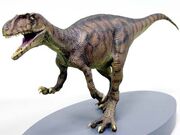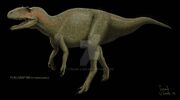| Fukuiraptor Temporal range: Early Cretaceous | |
|---|---|

| |
| A reconstructed skeleton of Fukuiraptor kitadaniensis | |
| Scientific classification | |
| Kingdom: | Animalia |
| Phylum: | Chordata |
| Class: | Sauropsida |
| clade: | Dinosauria |
| Superorder: | Theropoda |
| Genus: | †Fukuiraptor Azuma & Currie, 2000 |
| Species: | †F. kitadaniensis |
| Type species | |
| †Fukuiraptor kitadaniensis Azuma & Currie, 2000 | |
Fukuiraptor (foo-KWEE-rap-tor) was a genus of megaraptoran theropod dinosaur of the Early Cretaceous epoch (either Barremian or Aptian) that lived in what is now Japan. It was discovered in the Kitadani quarry near Katsuyama in the Fukui prefecture. A large claw was discovered that was first thought to be the sickle-claw belonging to a large, unknown member of the dromaeosaurid (or raptor) family of dinosaurs, so it was named Fukuiraptor, or "Fukui thief".

Fukuiraptor model
However, closer examination a few years ago and more bones discovered of this elusive predator proved that this was, in fact, a type of allosaurid theropod that was closely related to the more well-known Allosaurus. This is very similar to what happened with Fukuiraptor's close relatives Megaraptor and Sinraptor. The paleontologists believed that the huge claws of this narrow predator was a toe-claw iconic to the raptor family. However, based on the small size of this carnosaur it's been debated whether or not it was a juvenile, but a few years later several more specimens were found that were even smaller than the first specimen, so it's beginning to look like they didn't get very big. This is a very significant find in paleontology history because until then, we did not know that large carnivores were capable of living on the small island of Japan.

Two Fukuiraptor restored
Description
Fukuiraptor was quite small in terms of allosaurids, growing to be only about 14 feet (4.2 meters) long and weighing only about 450 lbs (200 kilograms) while its relative Allosaurus grew to be nearly 43 feet (13 meters) in length and nearly four tons in weight.

A life restoration of Fukuiraptor kitadaniensis
However, it was likely the biggest predator in its environment and was quite capable of eating about anything it could catch. Probably the most likely reason for its smallness is because of island-dwarfism, which is caused when an animal is trapped on a small island and throughout time it gets smaller and smaller to be able to survive by not having to eat or drink as much as it would being much larger. This is especially likely since Japan is such a small island and, because the sea-levels were much higher back then, would've minimized its size even more. It's not quite known what Fukuiraptor's main prey item would've been, but considering how short food supply was on the island it likely mostly survived on lizards, passing-by pterosaurs, or possibly even fish. Some people believe that the Fukuiraptor might've hunted down a possible rival, the Fukuisaurus, a Hadrosaur.

Dinosaur king Fukuiraptor
What's unusual about this relatively unknown megaraptoran is that it had relatively long arms with such large claws in relative to its body size, this could indicate that it was a skillful fisher and that may have been its main food source. Like other carnosaurs, Fukuiraptor was bipedal, and walked on two back legs with three toes with sharp talons on the ends. It had a long tail that was designed to help it walk more balanced and it had sharp, blade-like teeth that were designed to tear through the flesh of its unlucky victims.
In Popular Culture
Fukuiraptor was featured in an epsiode of the popular show Dinosaur King.
Fukuiraptor also appears in many forms of Paleoart.
References
http://www.redorbit.com/education/reference_library/science_1/dinosauria/2583126/fukuiraptor/